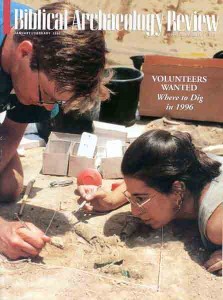The Zooarchaeological Record: Pigs’ Feet, Cattle Bones and Birds’ Wings
Sidebar to: The Fury of Babylon: Ashkelon and the Archaeology of Destruction
In the 1992 and 1993 seasons at Ashkelon, over 12,000 animal bones were found in the destruction debris now dated to 604 B.C.E.
About half of these bones were found in the street outside the square building called the Counting House. This suggests that this area was used for carcass processing, although part of the accumulation may have resulted from the fact that this area is a slight downslope and may have accumulated remains through erosion.
Several other considerations, in addition to the accumulation of bones, indicate that this was a carcass-processing area. Of the 43 articulations (bones found in anatomical relationship) that were excavated, the largest concentration (16) was found in this same area. Most of these articulations were of non-meaty portions of the carcass—“wrists” and “ankles” still attached to the toe bones of sheep or goats. This concentration of articulations indicates a scene of primary carcass processing in the months prior to the destruction of Ashkelon in the winter of 604 B.C.E.
Five of the animals represented by these feet were 16 to 24 months old when they died. Assuming they were born in the seasonal pattern typical for sheep and goats in the Near East, these feet came from animals that died in late fall or early winter. The age of the animals at death is consistent with the historical record, since Nebuchadrezzar’s destruction of Ashkelon in early winter would have sealed the deposit before the feet had a chance to be scattered by exposure to the elements, scavenged by dogs or trampled by traffic.
Three vertebral column sections were also found in this area. These sections were probably also a by-product of primary butchery.
Already a library member? Log in here.
Institution user? Log in with your IP address.

